EXECUTIVE SUMMARY
On November 5, 1996, voters of the City and County of San Francisco approved a $100 million general obligation called Proposition A—the Affordable Housing and Home Ownership Opportunity Bond. $85 million of the proceeds were to be spent for acquisition, rehabilitation and construction of rental units for households with annual incomes of no more than 60% of the median. $15 million was to go for down payment assistance loans for first-time home buyers with annual incomes at or below the San Francisco area metropolitan median (AMI). Supporters of the measure claimed in ballot arguments that the program would result in the creation of 3,000 new affordable housing units for low-income households.
There is a serious shortage of low-income housing in San Francisco. The Mayor’s Office of Housing (MOH) estimates that San Francisco needs 19,000 units of affordable housing of various types over the five-year horizon from 2001 to 2005. The Association of Bay Area Governments (ABAG) has estimated that San Francisco requires about 13,000 net new low- and moderate-income units between 1999 and 2006 just to meet the need arising from population growth and inadequacies of the existing supply.
By this summer (2002) when all funds will be committed, Proposition A will have financed 1,812 new and rehabilitated apartments and 264 beds in group-housing facilities. In addition, 240 loans will have been made to first-time homebuyers under the Down Payment Assistance Loan Program (DALP). 68% of the dollars under the rental program have gone to meet the housing needs of seniors, the homeless, the mentally ill, and other persons requiring “supportive” or “service-enriched” housing. The remainder was spent on family rental housing. Proposition A has met its goal of serving households with annual incomes at 60% of the area-wide median and below. 57% of all program participants and almost 70% of households served by the rental housing program have annual incomes at 50% of the area-wide median and below.
Proposition A has played a decisive role in expanding the production of affordable housing in San Francisco. Its 1,342 new rental apartments exceed the 1,061 new units of affordable rental housing that were built under all programs during the period from 1996-2000. Projects funded by Proposition A and the San Francisco Redevelopment Agency’s (SFRA) together are projected to significantly boost affordable production to an annual average of 730 new units from now through 2004. This is almost three times the 268 annual average produced during the prior fiveyear period.
Proposition A funds provides “deep” subsidies that help provide long-term affordability for very low-income households (50% of the area-wide median and below). Housing investment is normally financed with large amounts of conventional debt (up to 65% in market-rate rental and 95% in owner-occupied housing). Affordable projects minimize use of conventional debt in order to reduce the cash flow requirements and therefore the amount of rental income needed to service debt. Proposition A and the City’s other affordable housing programs do this by making large subordinate loans (usually referred to as “soft loans”) that carry below-market interest rates and deferred repayment provisions.
While Proposition A has been crucial in boosting affordable housing production in San Francisco, it has fallen short of reaching its stated goal of creating 3,000 new affordable housing units, even if one counts the rehabilitated units and group housing beds. Another way of saying this is that the program had lower “leverage” than anticipated. Program leverage as used here means the ratio of (a) financing provided by non-Proposition A funds to (b) financing provided by Proposition A funds. With a given amount of funding, the more leveraged the program is, the more units it will generate. After all funds are committed and spent, the leverage ratio for the Proposition A rental program is projected to be at about 2.2X. This is relatively low. Most affordable family rental programs in California have leverage ratios of 3.0 to 4.0X. During the past five years the SFRA’s affordable housing program achieved leverage of 4.5X.
Several factors account for Proposition A’s low leverage. First, development costs increased by almost 30% while incomes rose much more slowly. This meant a large affordability gap has to be filled by Proposition A money. This accounts for probably 2/3’s of the lower leverage. Second, a substantial portion of Proposition A funds were invested in “supportive housing.” “Supportive” housing is permanent housing which includes services including health care, employment assistance, and vocational rehabilitation. These services are provided as part of the housing package to persons who formerly were homeless or under institutional care so that they can successfully maintain an independent household. Few other sources of subsidy or financing programs exist for this type of housing. Third, Proposition A funds were invested in projects in 100% affordable projects and a large proportion of the units were targeted for very low-income households. More SFRA projects have tended to be mixed-income projects, which contain both market rate and low-income units. These projects are often financed with tax-exempt bonds and the below-market rate debt on the whole project helps to subsidize the low-income units.
In general terms, we face a trade-off between deeper subsidies to help the most needy or shallower subsidies which can produce more units or affordable housing and help more people. The approach taken by the Mayor’s Office of Housing with the Prop. A bond has been to emphasize deeper subsidies targeted to the people with the greatest needs. This approach is extremely important for populations with special needs such as homeless people. SPUR believes this emphasis on deeply subsidized supportive housing is appropriate. However, we also believe that there may be ways to generate more units, with higher leverage ratios, which would benefit people who are slightly better off—and are likely to have jobs—but who cannot afford market rents.
We believe that Proposition A has been successful and that the program should be extended. General obligation bonds are a way to buy housing affordability permanently and buy it only once. This is the lesson learned from the experience with the Federal Section 8 rent subsidy program which produced limited affordability (20 years). As these vouchers expire, the government is forced to buy the units from private building owners. The Federal government’s experience with the Section 8 program shows that when government invests in limited affordability it has ended up paying for subsidized housing twice, and at a much higher price the second time around. It is cheaper to do it only once. Issuing general obligation debt to construct affordable housing may be the only way to do that.
However, local affordable housing bonds will not be sufficient to fund the city’s affordable housing needs all by itself. In order to address the magnitude of the need, the City needs to find a way to leverage and mobilize more outside financial resources:
• The Mayor’s Office of Housing should spend a portion of the affordable housing bond on mixed income projects. This would allow the City to purchase affordable units in market rate projects above and beyond the requirements of the inclusionary housing law and the 20% affordable housing developments funded with State tax-exempt bonds. The City could try to partner with developers of market rate projects to put together 30%, 40% or 50% affordable housing projects as a way to leverage other financing sources.
• The Redevelopment Agency should try to extend its access to tax increment financing as the older redevelopment areas expire. State Bill 211 allows cities to extend the use of tax increment revenues for affordable housing, but the City has not yet taken the necessary steps to comply with this provision.
• The voters should pass the proposed $2 billion State affordable housing bond. Because so many jurisdictions are hostile to affordable housing, cities like San Francisco which support affordable housing stand to gain the most.
• The City should consider raising the real estate transfer tax as a long-term source of affordable housing. The nexus between rising property values and the need for affordable housing is clear. Moreover, the real estate transfer tax is economically efficient, in that it does not discourage socially desirable activities like job creation or housing construction.
We expand on these and several other recommendations in the main body of the report.
While it cannot solve the affordable housing crisis on its own, San Francisco’s affordable housing bond is a critical component of our housing policy. It should be renewed.
Analysis of the San Francisco Affordable Housing and Home Ownership Opportunity Bond Program
Introduction
On November 5, 1996, 67.7% of the voters of the City and County of San Francisco 1 approved Proposition A—the Affordable Housing and Home Ownership Opportunity Bond2—a $100 million general obligation bond to expand affordable housing opportunities for low- and moderate-income residents. $85 million of the proceeds were to be spent for acquisition, rehabilitation and construction of rental units for households with annual incomes of no more than 60% of the San Francisco metropolitan area-wide median ($62,000 in 1996). $15 million was to be invested in down payment assistance loans for first-time homebuyers with annual incomes at or below the area-wide median. Supporters of the measure claimed in ballot arguments that the program would result in the creation of 3,000 new affordable housing units for low-income households.
It took a full year for the Board of Supervisors to pass the ordinance that established program guidelines. The first $20 million of bonds were issued in March 1998. In June 1998 the first down payment assistance loans were made. An additional $20 million of the authorization was issued each following year except 2001 during which $40 million was issued. The Mayor’s Office of Housing (MOH) administered the program. The San Francisco Redevelopment Agency (SFRA) Commission was designated as the “Housing Committee.” Its duties are: to advise the MOH Director on allocation of funds and other aspects of the operation of the Program; and to recommend for the Mayor’s approval all applications for loans or grants for rental housing projects that have been reviewed and negotiated by MOH.3
The Board ordinance stipulates that the bond proceeds be deposited in two accounts: the Development Account for the rental housing program and the Down Payment Assistance Loan Account for the ownership component. 4 The Development Agreement has been used primarily to make deferred amortization project loans (with maturities up to 50 years) which are repaid out of project residual revenues. All principal and interest payments from these loans are deposited in the Development Agreement. The Down Payment Assistance Loan Account works in a similar way. Both are in effect revolving loan funds. Because repayments from the loans are not needed to repay the bonds, which are repaid from a dedicated property tax levy, these revolving loan funds are perpetually available for affordable housing investment.
There is little question that the need for low-income housing in San Francisco is substantial. For example, the MOH in its Year 2000 Consolidated Plan analyzed the “special” needs of groups who require housing in combination with some level of social service provision. This includes the homeless, the mentally ill, physically disabled, the elderly, large families with children, students and terminally ill patients. To meet these needs the City must develop 19,000 units of affordable housing of various types over the five-year horizon from 2001 to 2005. See Exhibit 1 below.
This estimate does not include the need for family rental housing by poor families and single persons who currently face excessive housing costs or live in overcrowded or substandard dwellings. The Association of Bay Area Governments (ABAG) quantified this more generic need in its Regional Housing Needs Analysis. ABAG estimated that San Francisco requires about 13,000 net new low- and moderate-income housing units over the period of 1999 to 2006 just to meet the need caused by population growth and inadequacies of the existing supply. Despite the different methodologies employed, both estimates confirm the popular impression that the need for affordable in San Francisco is substantial. Proposition A was passed largely because San Franciscans recognize this fact and that the 250 units of affordable housing added to the inventory annually by city-wide affordable housing programs was grossly insufficient to meet this need. More had to be done.
Exhibit 1: Estimates of Low-Income Housing Needs in San Francisco, 2000-2001
| Population Group | Type of Housing Required | Units |
| Mayors Office of Housing Estimate of Special Population Need | ||
| Homeless | Shelters, transitional housing, SRO's, small and large family rental | 3,500 |
| Mentally Ill | Board and care and institutional facilities | 2,000 |
| Physically Disabled | Accessible units of all kinds | 3,177 |
| Elderly | Senior housing projects, mainly studios and 1-bdrm units | 1,500 |
| Families with Children | Family rental with 2+ bdrm units | 4,000 |
| Students | Dorms and studio apartments | 1,000 |
| Terminally Ill Patients | Board and care and institutional facilities | 3,000 |
| Artists | SRO's studios 1-bdrm units | 1,500 |
Total 19,677 | ||
| ABAG Estimate of Housing Need | ||
| Very low | Elderly, small and large family rental | 5,244 |
| Low | Elderly, small and large family rental | 2,126 |
| Moderate | Elderly, small and large family rental | 5,639 |
Total 13,009 | ||
| Source: San Francisco, Planning Department, Housing Element 2001, Part 1, Draft for Public Review. | ||
By the end of this summer (2002), all of the bond proceeds will have been committed or spent. This is a good time to assess the accomplishments of the program and identify ways that it could be improved. SPUR supported passage of Proposition A in 1996. SPUR realizes that subsidized housing is by no means the entire answer to San Francisco’s housing crisis, but it also recognizes that producing low-income housing requires considerably more public intervention (including financial assistance) than does market-rate housing. This use of general obligation debt is therefore both appropriate and efficient, especially in the face of the long-term decline in Federal funding for low-income housing.
This paper looks at how Proposition A money was spent. This review included an analysis of data on commitment decisions provided to the SPUR Housing Committee by MOH.5 The paper also discusses certain aspects of Proposition A that continue to be the subject of public debate.
Whether reliance on non-profit developers is the most effective way to deliver low-income housing.
• The effectiveness of the down payment assistance program.
• The rationale for general obligation bond financing for affordable housing and other local revenue sources that could be used to subsidize affordable housing.
The paper concludes with several recommendations that the SPUR Housing Committee believes will improve the overall effectiveness of the program.
How Proposition A Money HAS Been Put to Use
By this summer, when all funds will be committed, Proposition A will have financed 1,812 rehabilitated and new apartment units and 264 beds in group-housing facilities.6 (See Exhibits 2 and 3 for a full breakout.) 1,342 of the apartments are new construction, 250 are conversions from military housing7 and 220 are rehabilitated units. 80 of the 264 beds were new construction; the rest were conversions or rehabs. To date, 400 units and 170 beds have been completed, 238 apartments are under construction, and 681 units and 94 beds are in permit processing and should be completed during 2002 and 2003. Another 495 rental units are currently under review by MOH for funding commitments and likely to be approved by summer. In addition, as of mid-May 2002, 210 loans were made to qualifying first-time homebuyers under the Down Payment Assistance Loan Program (DALP) and another 30 loans are to be funded sometime this summer.
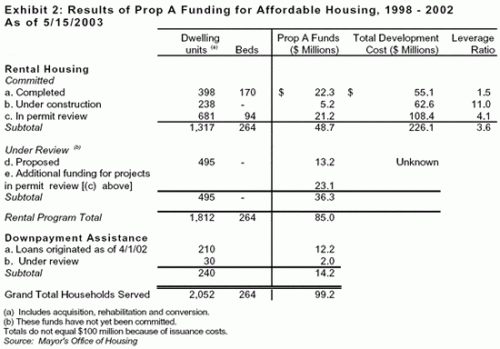
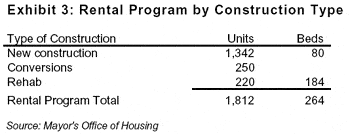
60% of the households served by the rental housing program were seniors and those with “special housing needs.” (See Exhibit 4 below.) The latter includes the homeless, the mentally ill, and other persons requiring “supportive” or “service-enriched” housing.8 35% of the dollar value of all project loans have gone to these segments. This is consistent with City policy, which has targeted 30% of all affordable housing resources for populations with special needs.9
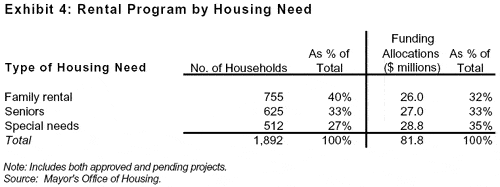
In addition, as Exhibit 5 indicates, Proposition A has met its goal of serving households with annual incomes at 60% of the area-wide median and below.10 57% of all program participants and almost 70% of households served by the rental housing program have annual incomes at 50% of the area-wide median and below.
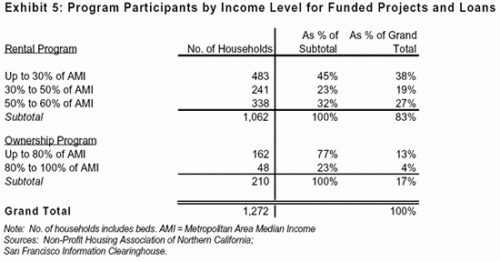
The unit mix of the conventional rental housing projects in the program reflects the need for large units (3+ bedrooms). By contrast, units with 3+ bedrooms comprise only about 10% of the city’s rental housing supply.11 The private market produces few rental units of this size. MOH believes that there is an estimated need for about 6,000 such units among households with annual incomes at 50% of the area-wide median and below. The large proportions of SRO and group housing beds is also consistent with the goals of the Year 2000 Consolidated Plan.
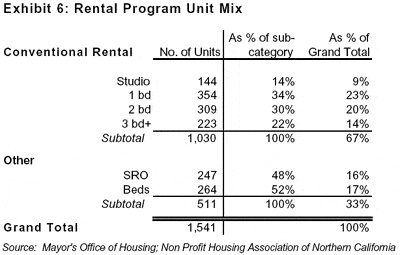
The Role of Proposition A in San Francisco’s Affordable Housing Effort
Proposition A has played a decisive role in expanding the production of affordable housing in San Francisco. It has financed 1,342 new rental apartments; this is better than the 1,061 new affordable rental units produced under all programs from 1996-2000. As Exhibit 7 shows, Proposition A is now the second largest source of local funds in San Francisco for subsidizing low-income housing after SFRA tax-increment funds and is equal in size to SFRA funds available for city-wide projects.
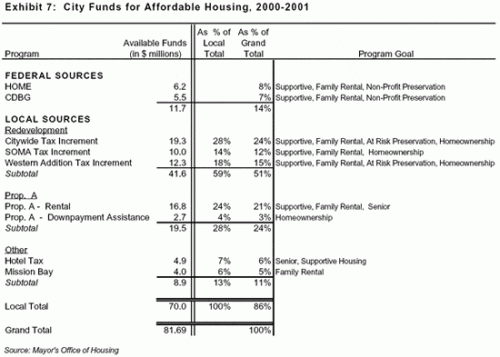
From 2001 to 2004, projects funded by Proposition A will on average account for about 48% of all affordable housing units completed in San Francisco. Most of the rest will be funded out of SFRA’s affordable housing program. The two programs together are responsible for significantly boosting affordable production during the past 18 months. As Exhibit 8 demonstrates, Proposition A and tax increment monies together will be responsible for an annual average of 735 new units of affordable housing from 2001 through 2004. This is almost three times the 268 annual average produced during the previous five-year period.
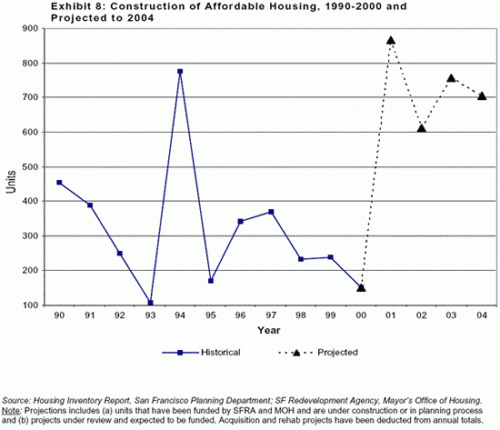
Proposition A has also been important to the City’s affordable housing effort because it provides “deep” subsidies. These contribute to long term affordability and help to provide affordability for very low-income households (50% of the area median income and below). Most affordable housing projects tend to have as many four, five, or even six layers of financing. In simplified form, these include:
1. Equity capital from private sources, most commonly from investors in partnerships structured to take advantage of federal and state low income housing tax credits.
2. Conventional debt financing, i.e., first mortgage loans with scheduled amortization usually from institutional lenders.
3. Grants or subordinated “soft loans” from: a. Federal and State low-income housing development programs. b. City programs, such as tax-increment funds or Proposition A bond money.
Housing investment is normally financed with large amounts of conventional debt (up to as high as 70% in market-rate rental and 95% in owner-occupied housing). Affordable projects, on the other hand, minimize use of conventional debt in order to reduce cash flow requirements and therefore the amount of rental income needed to service debt. Conventional debt rarely represents more than 35% of the financing of an affordable project. This is the main way that rents can be made affordable for very low-income households.
Normally, the equity investment is fixed. Hence, the only way that conventional debt can be minimized is by increasing the size of the soft loan from the local subsidy provider. These loans carry below-market interest rates and deferred amortization provisions. The larger the percentage of financing in a project represented by soft loans, the more affordability that can be structured into the project.
When used this way, Proposition A funds help to achieve long term affordability. The regulatory agreement the developer must sign as a condition of receiving a Proposition A project loan requires that all units be maintained as affordable housing for 50 to 70 years. Low conventional debt ratios make such agreements economically feasible. Proposition A loans are amortized out of residual receipts over 50 years (or even as short as 30 years) and paid off after all the other long-term liabilities in the project are retired. This means that long-term affordability is not at risk once the regulatory agreement expires. The project will have few if any liabilities and rents can be kept at low levels.
While Proposition A has played a crucial part in boosting affordable housing production in San Francisco, it has fallen short of reaching its stated goal of creating 3,000 new affordable housing units, even if one counts the new beds and rehabilitated units. A good portion of the shortfall was probably due to increased land and construction costs between 1996 and 2001. Total development costs may have increased as much as 40% during this period12 but incomes rose much more slowly. The result was a gap between what a low-income household could afford at a reasonable rent to income ratio and the rent level needed to support the higher capital cost of the housing. This mean that Proposition A funds had to fill a larger gap than originally anticipated.
However, some of it seems to be due also to low program leverage. Leverage measures the extent to which affordable projects funded by Proposition A also used other sources of subsidy and financing. Leverage is calculated as the ratio of (a) financing provided by non-Proposition A funds to (b) financing provided by Proposition A funds.13 When the total funding level is held constant, the more leveraged the program is, the more affordable units the program will generate.
The leverage ratio for the Proposition A rental program to date is 3.7X. However, after all funds are committed and spent, total program leverage will be lower than this. MOH plans to allocate two-third’s of its uncommitted funds (approximately $23.4 million) as additional support to projects now in the planning stage in order to enhance their affordability. (See Exhibit 2.) This will cause the total program leverage to end up at about 2.2X.
This is relatively low. Housing rehab programs have tended to have leverage ratios of 5.0 to 6.0X and affordable family rental construction programs ratios of 3.0 to 4.0X. During the past five years the SF Redevelopment Agency (SFRA) affordable housing program has achieved a leverage ratio of 4.5X .14
Several factors account for this low leverage ratio. First, increased development costs as mentioned above required that the program put in more money per unit to maintain targeted affordability levels. Second, a substantial portion of Proposition A funds were invested in “supportive housing” (see the Exhibits 3 above).15 Few other sources of subsidy or financing programs exist for this type of housing. SFRA, by contrast, has financed more family rental housing and low-moderate income condominiums for which substantial state and federal financing has been available. The SFRA has also been able to use Section 8 contracts to support considerable outside financing for its affordable housing projects. Finally, most Proposition A funded projects were 100% affordable—that is, virtually all the units in each rental projects were designed to be affordable by low-income households.16 Only a limited amount of conventional debt financing can be used for such projects; otherwise the rents will not be affordable. Hence, to achieve deep and long term affordability, Proposition A money on average has had to take a fairly large position in each project. On the other hand, more SFRA projects are mixed-income projects, which contain both market rate and low-income units. These projects are often financed with tax-exempt bonds, and the below-market rate debt on the entire project helps to subsidize the low-income units.
SPUR realizes that providing supportive housing and reaching the very lowest income groups are important program goals. But it also believes that producing more units is also an important goal especially in light of the need of 19,000 low-income households in San Francisco without affordable or appropriate housing. The more persons that can benefit from the use of local subsidies, the more effective these programs will be. But this means that the City has to be more aggressive about leveraging and obtain other sources of funds. Some of the recommendations at the end of the paper speak directly to that issue.
The Role of Non-Profits in San Francisco Affordable Housing Programs
No for-profit developers have come forth with projects and competed for Proposition A funds, although the Board ordinance and the Notices of Funding Availability published by MOH do not contain language that in any way limits participation by for-profit developers. This is of concern to SPUR to the extent that broader participation by the development community might help increase the volume of affordable housing produced.
What appears to be an institutional bias can be better explained by the fact that developing affordable housing is not profitable to begin with. Those who run the City’s affordable housing programs seek to ensure that most of the benefits of the subsidies they provide accrue to the low-income households served by these programs and not to housing producers. Housing officials in San Francisco have become extremely effective at doing this and have created a sophisticated set of controls and restrictions which developers (for-profit and non-profit alike) must agree to as a condition using City money. The effect of these restrictions is to greatly reduce profit opportunities and to increase negotiation and transaction costs to such an extent that for-profit developers with experience in affordable housing may simply not be interested in participating. In practice, it means that more money at the margin can go into the project itself, to enhance the design, add a day care center or a recreation center, or provide an additional family-size unit. From a taxpayer’s viewpoint, these restrictions represent effective stewardship by the City’s housing agencies of public resources.
Restrictions which make the program unattractive to for-profit developers include:
• The 50- year affordability restriction.
• Percentage and absolute dollar caps limit allowable developer fees that can be paid out during the construction period.17
• Regulatory agreement provisions requiring funding of operating and replacement reserves and for which a developer may have to make cash contributions.
• Other operating restrictions limiting cash flows that can be distributed to the developer or limited partnership investors during the operating period.
• Competitive bidding requirements, which limit use of affiliated contractors and suppliers.
These restrictions are not solely features of the Proposition A program. The SFRA’s affordable housing program contains similar restrictions. However, for-profit developers participate more in its affordable housing program because of their involvement in other redevelopment activities and because of the Agency’s access to Section 8 subsidies and its greater flexibility in assisting mixed-income projects.
The cap on developer fees is not the most restrictive element in the mix. Developers normally derive only a portion of their total profit from this source. Some of the profit also derives from the cash yield during operations, and some from profits made by affiliated construction companies. However, most profit comes from capturing market value appreciation at resale or refinancing within a number of years after project completion. The 50-year affordability restriction prevents this and severely reduces the market value of a project for a considerable period. Because the large publicly financed loan that remains on a project for 30 years or longer until paid off, the market value of the project will be less than the outstanding liabilities also for a very long period of time.
The opportunity costs of doing low-income housing development today for for-profit developers are huge. We have a very strong housing market right now in California because of low interest rates and a relatively mild recession. The marketplace today provides enough other opportunities, which, although riskier, have substantially more upside gain and a much more attractive expected return than does producing low-income housing given all of its regulatory and financial restrictions.
Some real estate groups have argued relaxing these restrictions and providing greater profit incentives would generate substantial savings for the City, because for-profit developers are more efficient and can produce at lower cost than non-profit developers. There is no evidence that this is the case.18 Most of these arguments are bolstered by spurious average cost comparisons that typically do not adjust for differences in design, quality, location, year of construction, and other characteristics that affect cost. It is important to keep in mind in this respect that non-profit and for-profit housing developers produce fundamentally different types of housing. Non-profit developers incorporate many more two- and three-bedroom units into their projects, or build in substantial social service components, including health care, child day care, adult day care, transportation services, etc. Few for-profit developers have the experience with this kind of product. This may be one reason why Federal programs which encourage “supportive” housing (such as the Section 202 Elderly Housing and Section 811 Housing for the Disabled Programs) require non-profit ownership and sponsorship as a condition for funding.
At the same time, both the for-profit and non-profit developer face the same cost structure when building affordable housing. For the most part, they use the same general contractors to do construction. Both types of developers—and their construction contractors—must comply with competitive bidding requirements, prevailing wage standards, MBE/WBE goals, and other laudable social policies built into contract specifications that are tied to use of public money. True, these hiring and contracting requirements may add between 10 to 30% to the cost of publicly-assisted housing in San Francisco; but that is a product of City policy and not the operating characteristics of the type of developer who produces the housing.
It is worth emphasizing that low-income housing development is a highly specialized business that requires expertise in producing under the complex labyrinth of rules and constraints imposed by government agencies which provide subsidies. Low-income housing developers must have a detailed understanding of federal, state and local subsidy programs. They must have experience with complex financial structures including tax exempt bonds, credit enhancement, government and foundation grants, and deferred amortizing subordinated loans. They need expertise in public contracting, knowledge of the procedures and policies of local housing and social service agencies, and experience operating under agency regulatory agreements which govern how the housing is managed and maintained and to whom it is rented. This is a narrow and highly specialized niche, and non-profits have generally been better at doing this kind of work than forprofits. For many communities in the Bay Area, the non-profit developers represent the only genuine delivery system for low-income housing production.
Finally, perhaps the most important benefit of having non-profits produce San Francisco’s affordable housing is permanent affordability. When the City’s 50-year restrictions expire, the units within non-profit ownership will continue to be rented at below market rates.
The San Jose Model
Even in jurisdictions outside of San Francisco, very few for-profit developers specialize in building 100% affordable rental projects for many of the reasons cited above. San Jose is sometimes cited as a model where for-profit developers have built substantial numbers of affordable units. SPUR conducted interviews with a number of individuals familiar with lowincome housing development in Santa Clara County to learn more about the San Jose experience. From these interviews, SPUR has concluded that a few private developers in San Jose do indeed build affordable housing,19 but they are in effect little different from non-profits. Most of them started in the business in the early 1990’s. They had virtually no prior experience in development but had managed to gain control of buildable sites. The San Jose Housing Department20 teamed up with these businessmen and essentially bankrolled them. The Housing Department reimbursed their acquisition costs and provided them with the risk capital needed to obtain construction loans. With consultants and guidance from the Housing Department, these businessmen learned how to set up tax credit partnerships in order to fund the permanent equity for their projects.
At the time the City of San Jose was eager to start an aggressive low-income housing building program. San Jose has only a few non-profits. None of the large established developers who built market-rate housing were interested in doing affordable projects. After a few initial successes, these entrepreneurs garnered support from the city council and along with further financial assistance from the Housing Department went on to produce close to 3,000 units of affordable housing over a 10-year period. All were part of 100% affordable projects subject to 55-year affordability restrictions. The developer profit is limited to a developer’s fee (capped at $1.2 MM as in San Francisco), a profit margin on the construction contract if they own construction affiliates, and a small periodic distribution from project cash flow. The projects are not managed by these developers but by companies with experience in low-income housing, such as the John Stewart Company.
These developers are for-profits in name only—otherwise their financing and business practices are the same as non-profits. They use the same financing techniques and are subject to the same rules, requirements and restrictions as non-profits. They are just as much creatures of public subsidy and politics as are non-profits—perhaps even more so.
The San Jose approach has some disadvantages. After the projects are completed, these developers have no incentive to provide services in their projects, but they do have an incentive to gradually increase rents over time in order to increase their returns. They also want out of the projects once they are built in order to avoid the partnership liabilities associated with federal recapture provisions which are inherent in tax credit deals. This model also limits the allocation of public monies to a small group of developers and therefore does not enlarge the field of opportunity or engender competition.
SPUR does not think that bankrolling for-profit developers or providing generous profit incentives for developers is the answer to increasing low-income housing production in San Francisco. However, SPUR believes that the City needs to increase the production of affordable housing. The non-profit sector has limited production capacity. If low-income housing goals, as described earlier in this paper (see Exhibit 1) are to be met, then the City must encourage broader participation by the development community in its affordable housing programs. Some of the recommendations at the end of the paper speak to this concern.
The Down Payment Assistance Loan Program (DALP)
15% of Proposition A funds were invested in the Down Payment Assistance Loan Program. Like the affordable rental program, SPUR believes that the DALP has been effective. Assisting lowand moderate-income households by providing greater access to home ownership as an instrument of social mobility is an important tool for enabling the lower middle class to remain in San Francisco, working against a city inhabited exclusively by rich and poor.
The DALP works as follows. The City makes down payment assistance loans that are to be repaid when the homeowner sells along with a portion of the appreciation in proportion to the City’s participation in the down payment. The turnover rate of these loans is short. Owneroccupied residences – and especially those of first-time buyers—normally turnover every 5 to 7 years—and even more rapidly when the market is strong. Hence, $15 million in down payment loans will be recycled at least four to five times over a 30-year period. The City’s income from property value appreciation upon resale increases the total size of the revolving fund available to make new down payment assistance loans during the next cycle.
DALP is an efficient program. The actual number of beneficiaries of the DALP is much greater than indicated by the proportion of initial bond proceeds allocated to it, because DALP is a revolving loan fund and has built into it a multiplier effect. What Proposition A has done is to capitalize a revolving loan fund. As long as the fund does not have to provide a source of repayment for the original bond issue and loans are properly underwritten to minimize credit losses, the fund’s capacity to make loans will grow over time.
Because of this revolving loan characteristic, the DALP multiplier is probably between 4.0x to 4.5x, after adjusting for inflation of home prices and expected credit losses. A multiplier of 4.0x means that total DALP beneficiaries will likely be 4 times greater than the number of initial loans made. Exhibit 9 below demonstrates the impact of the multiplier effect. $15 million in bond proceeds, which initially fund 250 down payment assistance loans, will likely generate as many as 1,000 down payment assistance loans over 30 years. Similarly, a 25% allocation of a $250 million bond issue will initially fund about 890 loans but likely generate as many as 3,600 over a similar period.

SPUR realizes that the DALP as currently structured is not a production program and therefore does not increase supply. This is a defect of the program. The low maximum sales prices of ownership units that qualify for assistance21 may cause DALP loans to become concentrated in specific lower-end sub-markets and possibly drive up prices in those sub-markets. To avoid this problem and to help expand supply, SPUR believes that a portion of DALP funds should be earmarked for new construction and single-family rehab.
Appropriateness of GO Bond Financing and Alternative Revenue Sources
Funding investment in low-income housing by means of general obligation debt is unusual although precedents do exist. Some cities in the East and the Midwest resorted to general obligation financing to construct public housing during the 1930’s and after World War II when the country suffered a serious housing shortage.22 Insofar as they are both property-tax supported debt, Proposition A bonds are similar to affordable housing bonds secured by tax increment revenues, which are widely used in California.
Local subsidies to actually construct housing units allow the City to buy housing affordability and buy it only once. This is the essence of the lesson learned from the federal government’s experience with the Section 8 rent subsidy program which produced limited affordability (20 years). Section 8 was an expensive proposition because when the subsidy contracts end, the feds had to pay for the affordable housing a second time, and at a much higher cost. It is cheaper to do it once. Clearly, two-thirds approval of a general obligation bond issue for affordable housing is as good an expression of consensus on these principles as one can possibly obtain in a democratic society.
But there are competing needs for the City’s debt capacity, and this is a concern. Proposition A as approved by the voters in 1996 used slightly over 12% of the San Francisco’s debt capacity at that time. Today, the City’s debt capacity is much higher, thanks to strong growth in property values during the past five years. Theoretical debt capacity, or the “legal margin,” is by state law calculated as 3% of the available property tax levy. As of June 30, 2001 the City’s legal debt margin stood at a little over $1.4 billion based on a levy (after exemptions) of $78.7 billion and after deducting outstanding net general obligation debt.23 A second affordable bond issue of $100 million would use up only 8.5% of the City’s current borrowing capacity, which is negligible. An issue of $250 million would use up 17.6%.
Actual, effective debt capacity is lower than $1.4 billion, because, if the City came close to using all of its debt capacity, it would run the risk of a rating downgrade. This would reduce the marketability of its debt and substantially increase the cost of borrowing. Actual debt capacity should be calculated on a margin of 2.7% of the levy. Actual debt capacity then is closer to $1.1 billion. A $250 million affordable bond issue would therefore likely consume almost 22% of actual debt capacity.
This is a substantial impact. The City’s debt capacity is likely to grow less in the near future due to a slower real estate market. Ultimately, the voters will need to weigh the competing priorities for use of GO bonds.
We should be clear that GO bonds cannot be the only source of funding for affordable housing. Even while we move forward with a renewal of the Prop. A program, we need to pursue additional sources of funding. On a State level, we believe the proposed $2 billion affordable housing bond will be particularly important for San Francisco.
On a local level, the City should explore the idea of raising the real estate transfer tax as a longterm source of funding for affordable housing. At 0.75% on all real property transfers in excess of $ 1 million, it generates about $50 million annually. The yield fluctuates greatly as property sales fluctuate from year to year, but transfer tax revenues have grown at a long term average of about 11% annually since 1985 mainly due to increased housing prices in San Francisco. A quarter percent increase (which would raise the maximum rate to 1.0%) might generate about $15 million a year under current market conditions and more during upswings in the real estate cycle. This revenue could not be used to secure a bond financing without some type of credit enhancement because the annual yield of this tax is so volatile. The money would have to be invested directly in projects. Although this yield is less than the annual average of $20 million under Proposition A, it would be a relatively permanent source of funds and steadily increase the size of the revolving loan funds created by Proposition A.
The Role of the Redevelopment Agency
One of the most important ongoing sources of local subsidy for affordable housing is tax increment revenue from the Redevelopment Agency. The SFRA collects about $34 million annually in tax increment revenues and currently budgets 50% of that for affordable housing. Most of the 50% allocation is used to secure tax-increment bond issues, the proceeds of which are invested in affordable housing projects in a manner similar to Proposition A funds. The SFRA’s allocation is far above the 20% required by state law and more than any other redevelopment agency in California devotes to affordable housing. The SFRA’s annual spending on affordable housing program is at an all time high level mainly due to the strong growth in assessed valuation during the latter half of the 1990’s. SFRA will spend about $40 MM for
affordable housing in FY 2001-2002. About half of this amount by law is earmarked for affordable housing activities in specific project areas. The rest is available for projects anywhere in the city.

The SFRA contends that little of the remaining 50% can now be used to replace Proposition A bond issuance because of Agency commitments to make programmed improvements in project areas for which tax-increment revenues are the only source of funding. However, if the City feels that investing in affordable housing is a compelling need, it may be worthwhile taking a second look at these commitments in order to determine if more tax-increment could be diverted to the
SFRA affordable housing program.
Aside from Agency allocation constraints, there is another reason that would preclude greater dependence on tax-increment collections to fund local housing subsidies. Beginning in FY 2004- 2005 the SFRA’s ability to fund affordable housing will be significantly curtailed because of the loss of tax increments in “old” project areas. AB 1290, adopted by the California legislature in 1994, sets time limits for redevelopment agencies to incur indebtedness, conduct activities, and collect tax increment in project areas with plans adopted before 1994. Under this provision of
AB 1290, six of the Agency’s eleven project areas are scheduled to sunset January 1, 2004.
These expirations will reduce current allocations from current high levels to well below $20 million annually and prevent the Agency from realizing approximately $207 million in bonding capacity for affordable housing during the period 2004-2014.
Last year, John Burton got the state legislature to pass SB 211. This bill allows communities, including San Francisco, to incur additional indebtedness for affordable housing purposes for an additional ten years beyond the limits established by AB 1290. However, to do this requires that redevelopment project area plans be amended and approved by area property owners and other affected parties. These amendments have not yet been drafted or approved. If voters do not
approve a new affordable housing bond issue this fall, then expediting those plan amendments will be a high priority.
RECOMMENDATIONS
SPUR finds that the Proposition A affordable housing bond has been successful and believes that the program should be extended. It also thinks that the program has some shortcomings that should be addressed in the future.
1. Increase program leverage to generate a larger total number of affordable housing units. Although many of the reasons for low leverage were valid—escalating development costs during the economic boom and a focus on deeply subsidized supportive housing units—it is still important for the City to try to increase the units produced for the amount of money invested. This means having the Mayor’s Office of Housing establish a more clear policy mandate to maximize the unit count, and holding developers accountable for the leverage ratios of their projects as one indicator of success.
2. Use Prop. A funds for mixed income projects. This would allow the City to purchase affordable units in market rate projects above and beyond the requirements of the inclusionary housing law and the 20% affordable housing developments funded with State tax-exempt bonds. The City could try to partner with developers of market rate projects to put together 30%, 40% or 50% affordable housing projects as a way to leverage other financing sources.
3. Look for alternative local funding sources for affordable housing. In particular, explore the possibility of increasing the real estate transfer tax for affordable housing.
4. Extend the Redevelopment Agency’s tax increment for affordable housing. The SFRA should take all steps necessary to comply with SB 211 in order to retain the use of tax increment revenues for affordable housing collected from the older redevelopment districts subject to state sunset provisions.
5. Dedicate a portion of DALP funds for new construction and single family re-hab. Of new bond funds devoted to home ownership, the City should spend some portion of the money on actually increasing the supply of housing, not just helping certain people bid for the existing supply.
But most importantly of all, we as the voters of San Francisco should reauthorize a bond measure to pay for more affordable housing. This program is an expression of deeply held values of the citizenry: equity, opportunity, and the universal right to a home.